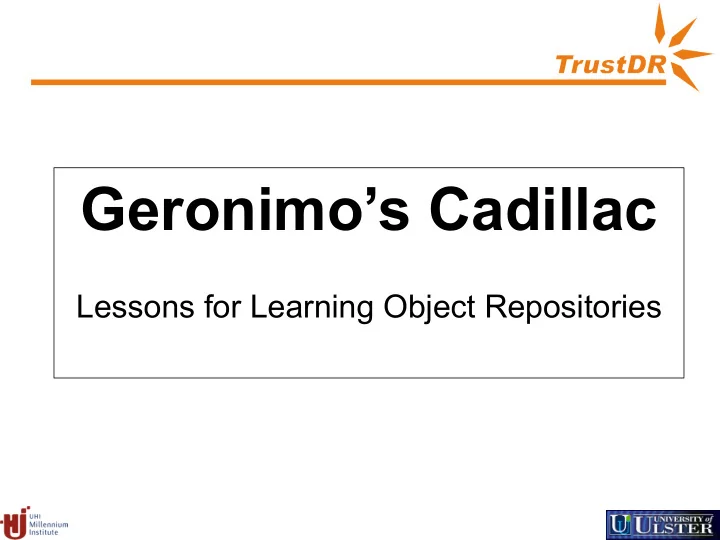

Geronimo’s Cadillac Lessons for Learning Object Repositories
Sergeant, sergeant, don’t you feel There’s something wrong with your automobile Governor, governor, ain’t it strange They didn’t have no cars on the Indian range Geronimo’s Cadillac - Michael J. Murphy
Common Themes • E-learning, IPR & DRM - same ‘problem space’ – Process Change – Organisational Models – Pedagogy – Systems Theory – Software Engineering – Mental Models – The ‘Political Economy’ of E-Learning • IPR & DRM - as a locus for change
“The current situation can best be described as high-level ambitions with poor implementation” (van der Klink & Jochems, 2004, pp 151)
Key Points • Attempts to implement e-learning are revealing underlying problems in structure and and culture – e-learning as a reification agent (Pollock & Cornford, 2000) • What does this mean? - much of what is assumed is incorrect (UK e-U) • These technologies carry a strong organisational and pedagogical model - to use them you have to change (Freisen, 2004) • E-learning will be ineffective without the necessary changes in the structure of institutions and changes to working practices • Main obstacles are philosophical, pedagogical, political, and organisational - the technical issues are comparatively minor • Current concentration on technical issues is a ‘displacement activity’
What has this got to do with IPR & DRM? • shares many of the general problems associated with e- learning in general – particularly the largely unexplored area of organisational change and development. • acts as a ‘lightening conductor’ to bring to the surface many difficult problems: – ownership – power – control – status • IPR & DRM as an enabler, as a locus…
A Systems Approach is Required - Big Picture Stuff! Pedagogical framework, educational setting, organisational context From Effective networked learning in higher education: notes and guidelines, Lancaster University & JISC JCALT
• Lots of guidance already exists – Laurillard, Twigg, Ramsden, Postle, Goodyear et al, • Tradition, dominant groups and vested interests will delay and obstruct the adoption and dissemination of new knowledge as the history of science shows (Kuhn, 1996). • Needs top-down action
Here and There…. Here There
A Mirror Image of E-Learning… senior management engaged accurate MIS information Functional teaching and research separate management by analysis long-term techno-sceptic systematic sustainable evaluation collective core business design once use many E-learning no evaluation design once use once techno-fetish individual Business not understood unsustainable short-term fragmented management by budget teaching and research conflated Dysfunctional ‘enterprise’ rhetoric but no senior management disengaged decent MIS
Tools to Support a Systems Approach Fig. 2 Basic Analysis and Audit Tool Derived from the Model derived from van der Klink & Jochems, 2004 TrustDR Organisational Model
The Future of E-learning? “Geronimo, last free leader of the Apache nation agreed to a peace treaty and was sent to live on a reservation. As a peace offering the US government made a gift to Geronimo of what was at that time one of the most advanced items of technology they had – a new Cadillac motor car. Geronimo was forced to pose in it for photographs but after this the car was used as a chicken coop.” www.digitalinsite.co.uk
References van der Klink, M., & Jochems, W. (2004) Management and organisation of integrated e-learning in Integrated E-Learning: implications for pedagogy, technology and organisation, Jochems, W., van Merriënboer, J., and Koper, R., Routledge & Falmer, London, Pollock, N. & Cornford, J. 2000. Theory and Practice of the Virtual University: report on UK universities use of new technologies. In ARIADNE issue 24 . http://www.ariadne.ac.uk/issue24/virtual-universities/ Twigg, C (2005) Keynote Summary: Improving Learning and Reducing Costs - New Models for Online Learning in the ALT-C 2005 conference, ALT-C, UK. http://www.alt.ac.uk/altc2005/keynotes.html#carol Goodyear, P., et al (2001) Effective Networked Learning in Higher Education: Notes and Guidelines, by The Centre for Studies in Advanced Learning Technology Lancaster University Commissioned by JISC and available at http://csalt.lancs.ac.uk/jisc/guidelines.htm Friesen, N. (2004) Three Objections to Learning Objects and E-Learning Standards. In McGreal, R. (Ed.) Online Education Using Learning Objects . London: Routledge. Pp. 59-70. Draft version online at: http://www.learningspaces.org/n/papers/objections.html
References Ramsden, P. 1991. Learning to Teach in Higher Education , Routledge, London Postle et al, (2003) Online Teaching and Learning in Higher Education: A Case Study , by the University of Southern Queensland, Australia, available from the Australian Government web site at: http://www.dest.gov.au/sectors/higher_education/publications_resources/other_publications/online_teaching_an d_learning_in_higher_education.htm Laurillard, D., (1994) Rethinking University Education , Routledge and Falmer
Recommend
More recommend